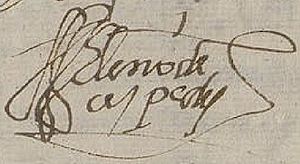Eleno de Céspedes facts for kids
Eleno de Céspedes, also known as Elena de Céspedes (1545 – died after 1588), was a Spanish surgeon who married a man and later a woman, and was tried by the Spanish Inquisition. Céspedes may have been an ... and/or transgender person, or, if a woman, may have been a lesbian and/or the first female surgeon known in Spain and perhaps in Europe.
Contents
Early life, first marriage, and travels
Elena de Céspedes was born around 1545 in Alhama de Granada in Andalusia, Spain, to an enslaved black Muslim woman named Francisca de Medina and a free, Christian, Castilian peasant named Pero Hernández. Born into slavery, and branded on the cheeks as the mulatto offspring of a slave, Céspedes was freed as a child (and took the surname of a former owner's wife), and married a stonemason named Cristóbal Lombardo at age fifteen or sixteen. Within a few months, while Céspedes was pregnant with his child, Lombardo left because the two did not get along. According to Céspedes, Lombardo died some time later.
Céspedes said that an ... condition became apparent while giving birth, and after giving birth, Céspedes left the baby boy (named Cristóbal after his father) with a friend and began to travel around Spain, working in various professions including as a tailor. ..... ... [and] as a soldier ... to put down the Morisco rebellion ... Soyer (2012) }}
Céspedes then found work as a farmhand and shepherd, but an acquaintance denounced him to the corregidor who arrested him, and released him only on condition that he dress as a woman. Undeterred, he resumed dressing as a man and found work as a soldier, putting down the Morisco Revolt. Céspedes, who was literate, then purchased several books on surgery and medicine, and with these and the help of a Valencian surgeon he had befriended, trained himself to be a surgeon in Madrid.
Second marriage, arrest, and trial
In December 1584, Céspedes and a woman named María del Caño, the daughter of an artisan, applied to marry.
..... In 1586, when Céspedes was forty and Caño was twenty-four, the couple were finally married; they lived together in Yepes in the vicinity of Toledo, Spain for a year.
..... The bailiff asked the vicar general to punish the couple severely; the penalty for female homosexuality was death. However, the Toledo tribunal of the Spanish Inquisition ordered the secular and episcopal authorities to turn the case over to them, because the charge of witchcraft was within the Inquisition's jurisdiction; the couple were therefore transferred to an Inquisition jail in Toledo.
..... He said this organ was initially curved downward by skin, but a surgeon was able to successfully sever this skin.
.....
Many of the physical signs inquisitors focused on were also racial; they noted, for example, that Céspedes had no facial hair and had pierced ears, like a (Castilian) woman; Lisa Vollendorf says that Caño is not recorded as indicating whether she thought, for example, that mulattoes might have less facial hair than Castilians or that enslaved people often pierced their ears. Inquisitors also argued Caño should have noticed when Céspedes menstruated, which Céspedes said he had done, though he had always had an infrequent cycle; Caño said that when Céspedes had blood on his nightshirt, he told her it was from bleeding (of hemorrhoids or wounds) caused by horseback riding.
Verdict and sentence
..... It imposed the standard sentence imposed on male bigamists in that era, 200 lashes and ten years of confinement. Céspedes was also subjected to a public humiliation, an auto-da-fé, being paraded around Toledo's central square in a sanbenito mitre and robes.
On account of his medical skills, Céspedes was ordered to spend his ten-year sentence caring for the poor in a public hospital, initially the Hospital del Rey in Toledo. However, many people came to see and be healed by the now well-known Céspedes, so on 23 February 1589 the administrator there requested Céspedes be transferred to a more remote facility, saying his presence was causing an "annoyance and embarrassment". The tribunal exonerated Caño of knowingly doing anything wrong, and released her.
See also
 In Spanish: Eleno de Céspedes para niños
In Spanish: Eleno de Céspedes para niños
- Catalina de Erauso (1585–1650), Spanish nun and conquistador
- Fernanda Fernández (1755–fl. .....


